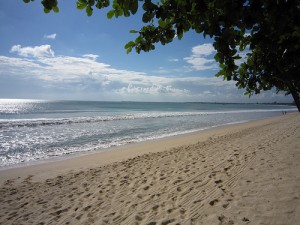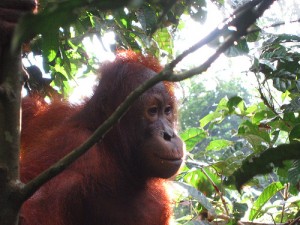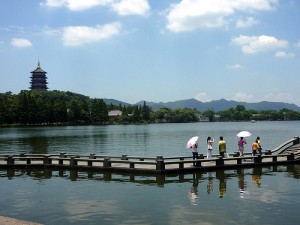December 30, 2009, 10:23 pm
 While traveling in Indonesia, I had the great fortune of spending a week on the island of Bali. If you have never been, you should definitely add it to your list of places you have to see. Bali is incredibly beautiful and full of lovely, nice people. When you’re in Bali, you must be sure to travel all around the island to see all that it has to offer.
While traveling in Indonesia, I had the great fortune of spending a week on the island of Bali. If you have never been, you should definitely add it to your list of places you have to see. Bali is incredibly beautiful and full of lovely, nice people. When you’re in Bali, you must be sure to travel all around the island to see all that it has to offer.
My days in Bali consisted mostly of lazily laying on Kuta beach. It is the main touristy beach in Bali which is full of all the tacky touristy things you’d expect, including Starbucks. I did try my hand at surfing a couple times, though, but couldn’t stand up for any great length of time. If you do attempt some surfing lessons, beware. It is incredibly addicting. The water in Bali is to die for, so even if you don’t try surfing, it is great for a swim.
You can stay in some pretty neat hotels in Bali that are made-up in the traditional Hindu flare. The hotel where I stayed was decorated like a palace. There is a lot of Hindu decor all over the island as Hindu is the main religion.
During my week stay I also managed to take a day trip into Ubud, Bali’s cultural center. Ubud is a must-see if you are in Bali and you can get some really cool art there. We went north of Ubud, to Taro to take an elephant ride. We had already ridden an elephant in India, but this was neat as well. You get to feed it and give it a bath after your ride.
You cannot be bored in Bali as there are always things to see and discover. And as is the case with many South-East Asian hot spots, the night life is fabulous. I met some great fellow travelers at the local pub near where I was staying. We even traveled to Malaysia together afterwards.
December 25, 2009, 10:23 pm
 While in Malaysia I had the great opportunity to trek through the Borneo jungle. Sabah offers a wide range of sightseeing activities in its pristine jungle. We opted for a day trek into the Kinabatangan Wetland. It is a great place to spot some exotic monkeys which we did. The wetland is just a couple hours southeast of modern Sandakan, which is not far from the Sepilok Orang-utan centre.
While in Malaysia I had the great opportunity to trek through the Borneo jungle. Sabah offers a wide range of sightseeing activities in its pristine jungle. We opted for a day trek into the Kinabatangan Wetland. It is a great place to spot some exotic monkeys which we did. The wetland is just a couple hours southeast of modern Sandakan, which is not far from the Sepilok Orang-utan centre.
The wetland cover 25000 Hectares of land and it is rated as having the highest concentration of primates in all of Borneo. We took a river ride with a guide to sight the strange looking Proboscis monkey which is only found in Borneo. Besides all the monkeys we saw, we also saw some pretty cool birds.
After the Kinabatangan Wetland, we went to the Sepilok Orang-utan centre because I’m obsessed. The centre is a great place to see these fascinating primates in their natural habitats. We got to see them during an afternoon feeding which let us spot them at very close range. It was a once in a lifetime experience and I would recommend it to anyone going to Borneo.
Our largest excursion was our trip into the Tambunan. It offers visitors a chance to see the world’s largest flower, the Rafflesia. It is definitely something to see. It is massive and very strange looking. While in Tambunan you can also picnic by waterfalls, hike through the rainforest, and climb Mt. Trusmadi.
We had the opportunity to climb Mt. Trusmadi, which is the second highest peak in Sabah. It is worth all the work of climbing it when you reach the top and get to look out over the beautiful landscape. You can see the islands and the rice fields and, when we were atop it, everything appears engulfing in a beautiful mist. It is definitely picturesque so don’t forget your camera.
December 17, 2009, 1:02 am
 The picturesque city of Hangzhou, located 118 km. south of Shanghai, makes for a lovely day or overnight trip for tourists staying in Shanghai. It offers a relaxing break from your time in the bustling metropolis. Catch the express train from the main Shanghai train station and it is approximately a 2.5-hour train ride to the city. Hangzhou has been a well-known place for reflection and escape for centuries. Historically it was an imperial retreat for Chinese Emperors and their families.
The picturesque city of Hangzhou, located 118 km. south of Shanghai, makes for a lovely day or overnight trip for tourists staying in Shanghai. It offers a relaxing break from your time in the bustling metropolis. Catch the express train from the main Shanghai train station and it is approximately a 2.5-hour train ride to the city. Hangzhou has been a well-known place for reflection and escape for centuries. Historically it was an imperial retreat for Chinese Emperors and their families.
West Lake is one of Hangzhou’s most famous sites and over the years poets, revolutionary Chinese heroes and even Marco Polo have praised its still waters. West Lake appears like a traditional Chinese Garden on a large scale. The lake is divided by causeways and has several man-made islands scattered throughout. Around the lake there are bike and paddleboat rentals. Bear in mind that if you are visiting in the summer it will be hot and humid. Be sure to keep yourself hydrated.
Hangzhou is known for producing some of the highest quality green tea in all of China and there are several tea villages in the West Lake district. It is a short taxi ride from West Lake to the tea fields where you can walk amongst the plants or if you are lucky catch a farmer or two drying the tealeaves. If it is a weekend you are also likely to see a few wedding parties posing for pictures. Travel tip in order to catch another taxi back you will need to return to the main road.
Jingci, Lingyin, and Yue-Wang are all Buddhist temples located in and around Hangzhou. Lingyin is one of the largest Buddhist temples in China. You could spend several hours there wandering through the many pagodas and Buddhist grottoes. There are also impressive reliefs carved into the cliffs and caves. In the darker caves the carvings are only visible by the light of the camera flash. The most famous carving is the Feilai Feng or “the peak that flew hither.” All of the temple sites contain giant wooden carvings of the different forms of Buddha.
Hangzhou is also famous for beautiful silks and satins. The biggest silk wholesale and retail market in China, Hangzhou Silk City, is located here. Silk City has more than 600 silk vendors selling a wide variety of products from clothing to scarves and ties.
Qinghefang Street in the historic district is a must see for anyone with an interest in history. The street is lined with well-preserved buildings from the Southern Song Dynasty as well as the Ming and Qing dynasties.
The modern commercial center of Hangzhou is located along the Yanan Road. Zhejiang Provincial Great Hall of the People, Hangzhou Culture Center, Victory Theatre, and the International Mansion are all places of interest.
Insider tip- when you are ready to catch the train back to Shanghai after a long day of site seeing enter through the first class entrance. The other main entrance at peak times can be a mob scene.
December 9, 2009, 1:01 am
 Well-traveled non-Mandarin or Cantonese speaking readers I have a test for you- name a famous Chinese pop singer. Could you do it? If you did– now name another. Lost yet? The point is much of Chinese popular culture is not publicized in Europe or the Americas. But here is a question I bet more of you can answer- who are Ling-Ling and Hsing Hsing? If you said Pandas- you are right, if you said Giant Pandas you get a bonus point!
Well-traveled non-Mandarin or Cantonese speaking readers I have a test for you- name a famous Chinese pop singer. Could you do it? If you did– now name another. Lost yet? The point is much of Chinese popular culture is not publicized in Europe or the Americas. But here is a question I bet more of you can answer- who are Ling-Ling and Hsing Hsing? If you said Pandas- you are right, if you said Giant Pandas you get a bonus point!
The Giant Panda is one of China’s most successful and historic cultural ambassadors. As early as the Tang Dynasty (618-907) there is record of a Chinese emperor sending pandas as gifts to Japan. The practice became famous when US President Richard Nixon visited China in 1972 and was gifted Ling-Ling and Hsing-Hsing. The pair instantly became one of the most popular exhibits at the National Zoo in Washington DC. Several generations of school children- this writer included- have grown up giving elementary school reports about these beautiful animals.
If you still have childhood fondness for these cuddly giants you shouldn’t make a trip to China without a trip to the Chengdu Research Base of Giant Panda Breeding (the base) in Sichuan province.
Despite its popularity the Giant Panda remains on the endangered species list where it has been decades. However there are major efforts underway to preserve panda habitats and help them breed. The panda’s natural home is the central mountain ranges of China including the Sichuan, the Shaanxi and Gansu provinces. There are two major Giant Panda Reserve Centers, The Wolong Giant Panda Reserve Center and the The Chengdu Research Base of Giant Panda Breeding. The Wolong Center was devastated by the May 12, 2008, earthquake and is now in the process of rebuilding. The Chengdu Research Base was not physically damaged but tourism to the base since the earthquake has dropped exponentially.
The Chengdu Research Base is located 6 miles outside of Chengdu City. It was founded in 1987 with six pandas rescued from the wild. It has grown to become an internationally recognized research and educational facility. As of 2008 the Giant Panda population of the base was up to 83 individuals. The base is designed to exist in harmony with the surrounding environment in order to best simulate the Giant Pandas natural habitat. In addition to Giant Pandas the base is home to Red Pandas and other endangered Chinese animals. The base provides daily, guided tours of the grounds. It also includes a new interactive Giant Panda museum for tourists and local school groups. For those travelers interested in supporting the pandas in the long-term, you can participate in the “adopt a panda” program.
Travelers interested in volunteering should consider the Giant Panda Center in Bifengxia in Ya’an City. The Wolong Center previously accepted volunteers but is currently closed due to the earthquake damage. The Giant Pandas from Wolong have now been moved to the sister Center Bifengxia. Bifengxia is accepting individual and group volunteers. However, the trips must be prearranged with partner travel agencies.
 While traveling in Indonesia, I had the great fortune of spending a week on the island of Bali. If you have never been, you should definitely add it to your list of places you have to see. Bali is incredibly beautiful and full of lovely, nice people. When you’re in Bali, you must be sure to travel all around the island to see all that it has to offer.
While traveling in Indonesia, I had the great fortune of spending a week on the island of Bali. If you have never been, you should definitely add it to your list of places you have to see. Bali is incredibly beautiful and full of lovely, nice people. When you’re in Bali, you must be sure to travel all around the island to see all that it has to offer. While in Malaysia I had the great opportunity to trek through the Borneo jungle. Sabah offers a wide range of sightseeing activities in its pristine jungle. We opted for a day trek into the Kinabatangan Wetland. It is a great place to spot some exotic monkeys which we did. The wetland is just a couple hours southeast of modern Sandakan, which is not far from the Sepilok Orang-utan centre.
While in Malaysia I had the great opportunity to trek through the Borneo jungle. Sabah offers a wide range of sightseeing activities in its pristine jungle. We opted for a day trek into the Kinabatangan Wetland. It is a great place to spot some exotic monkeys which we did. The wetland is just a couple hours southeast of modern Sandakan, which is not far from the Sepilok Orang-utan centre. The picturesque city of Hangzhou, located 118 km. south of Shanghai, makes for a lovely day or overnight trip for tourists staying in Shanghai. It offers a relaxing break from your time in the bustling metropolis. Catch the express train from the main Shanghai train station and it is approximately a 2.5-hour train ride to the city. Hangzhou has been a well-known place for reflection and escape for centuries. Historically it was an imperial retreat for Chinese Emperors and their families.
The picturesque city of Hangzhou, located 118 km. south of Shanghai, makes for a lovely day or overnight trip for tourists staying in Shanghai. It offers a relaxing break from your time in the bustling metropolis. Catch the express train from the main Shanghai train station and it is approximately a 2.5-hour train ride to the city. Hangzhou has been a well-known place for reflection and escape for centuries. Historically it was an imperial retreat for Chinese Emperors and their families. Well-traveled non-Mandarin or Cantonese speaking readers I have a test for you- name a famous Chinese pop singer. Could you do it? If you did– now name another. Lost yet? The point is much of Chinese popular culture is not publicized in Europe or the Americas. But here is a question I bet more of you can answer- who are Ling-Ling and Hsing Hsing? If you said Pandas- you are right, if you said Giant Pandas you get a bonus point!
Well-traveled non-Mandarin or Cantonese speaking readers I have a test for you- name a famous Chinese pop singer. Could you do it? If you did– now name another. Lost yet? The point is much of Chinese popular culture is not publicized in Europe or the Americas. But here is a question I bet more of you can answer- who are Ling-Ling and Hsing Hsing? If you said Pandas- you are right, if you said Giant Pandas you get a bonus point!